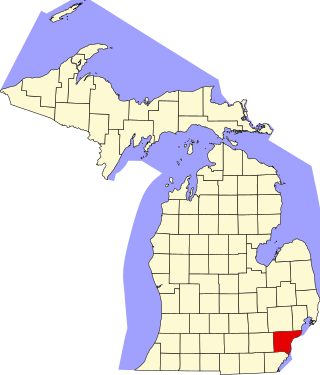
This is a list of the National Register of Historic Places listings in Wayne County, Michigan.

The American Precision Museum is located in the renovated 1846 Robbins & Lawrence factory on South Main Street in Windsor, Vermont. The building is said to be the first U.S. factory at which precision interchangeable parts were made, giving birth to the precision machine tool industry. In recognition of this history, the building was declared a National Historic Landmark in 1966. In 1987, the building was recognized by the American Society of Mechanical Engineers as an International Heritage Site, and the collection was recognized as an International Heritage Collection. For each of these designations, the armory was considered a site where pivotal events occurred in the history of American industry, as well as a place that lends itself to comprehensive interpretation of that history.

National Park Service rustic – sometimes colloquially called Parkitecture – is a style of architecture that developed in the early and middle 20th century in the United States National Park Service (NPS) through its efforts to create buildings that harmonized with the natural environment. Since its founding in 1916, the NPS sought to design and build visitor facilities without visually interrupting the natural or historic surroundings. The early results were characterized by intensive use of hand labor and a rejection of the regularity and symmetry of the industrial world, reflecting connections with the Arts and Crafts movement and American Picturesque architecture.
Canadian Forces Base London is a former Canadian Forces Base that was located in London, Ontario, Canada. It was downsized and closed during defence budget cutbacks in the 1990s. Local Primary Reserve units were supported by Area Support Unit (ASU) London which was located in some of the remaining base buildings, but they are now supported by ASU Toronto. Much of this support is delivered by a Technical Services Platoon which remains stationed in London.

The Colt Armory is a historic factory complex for the manufacture of firearms, created by Samuel Colt. It is located in Hartford, Connecticut along the Connecticut River, and as of 2008 is part of the Coltsville Historic District, named a National Historic Landmark District. It is slated to become part of Coltsville National Historical Park, now undergoing planning by the National Park Service.

Clark Equipment Company was an American designer, manufacturer, and seller of industrial and construction machinery and equipment.

The Crane and Company Old Stone Mill Rag Room is one of the oldest surviving buildings of Crane & Co., one of the oldest papermaking businesses in Berkshire County, Massachusetts. It is located in southwestern Dalton, on a site where paper has been manufactured since the early 19th century. The building, originally used for processing rags, has housed the Crane Museum of Papermaking since 1930, and was designated a National Historic Landmark in 1983.

This is a list of the National Register of Historic Places listings in Detroit, Michigan.

The Cass Park Historic District is a historic district in Midtown Detroit, Michigan, consisting of 25 buildings along the streets of Temple, Ledyard, and 2nd, surrounding Cass Park. It was listed on the National Register of Historic Places in 2005 and designated a city of Detroit historic district in 2016.

The Saco–Pettee Machine Shops is a historic factory complex at 156 Oak Street in the Newton Upper Falls area of Newton, Massachusetts. Although the area has an industrial history dating to the early 19th century, the oldest buildings in this complex, consisting of about thirteen brick buildings, were built in 1892. The property, a major economic force in the development of Newton Upper Falls, was listed on the National Register of Historic Places in 1986. It was home to Clark's N.A., the North American home base to Clark's Shoes, makers of fine footwear, until they relocated to Waltham Ma. in October 2016.

The Barnesville Historic District consists of the oldest part of Barnesville, Ohio, originally platted in 1808 and contains roughly 40 acres and 180 buildings. The district was added to the National Register on July 19, 1984.

The Weis Manufacturing Company, currently known as WoodCraft Square, is a former factory located at 800 West 7th Street in the city of Monroe in Monroe County, Michigan. It was listed as a Michigan Historic Site and added to the National Register of Historic Places on October 26, 1981.

This is a list of the National Register of Historic Places listings in Downtown and Midtown Detroit, Michigan. It is intended to be a complete list of the properties and districts on the National Register of Historic Places in Downtown and Midtown neighborhoods in Detroit, Michigan, United States. Latitude and longitude coordinates are provided for many National Register properties and districts; these locations may be seen together in online maps.

The Sussex County Historical Society is a non-profit organization incorporated in 1904 in the State of New Jersey. It is located in Newton, in Sussex County, New Jersey, United States, and pursues a mission of promoting public knowledge and interest in the county's heritage.

The Louden Machinery Company was an American engineering, manufacturing and design company based in Fairfield, Iowa. Founded by William Louden, the company in its early years manufactured and sold the patented hay carrier that he invented in 1867. The company later expanded into a wide variety of farm equipment and, in 1906, began an Architecture Department that reportedly designed more than 25,000 barns from 1906 to 1939. During World War I, Louden's monorail equipment carrier began to be applied to industrial and military applications. By the 1920s, much of the company's revenues were derived from industrial applications of its monorail equipment carriers.
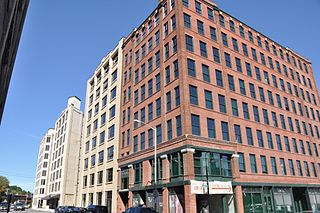
The L.H. Hamel Leather Company Historic District encompasses the largest tract of intact historical industrial buildings in downtown Haverhill, Massachusetts. The monumental factory complex of the L.H. Hamel Leather Company is located just west of Haverhill's central business district, and is roughly bordered on the west by the right-of-way for the former Boston & Maine Railroad, Essex Street on the south, Locke Street and Duncan Street on the east, and Winter Street on the north. The complex, which was built up between 1886 and 1929, was listed on the National Register of Historic Places in 2009.
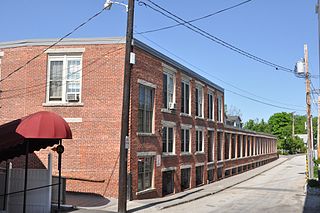
The Milford Cotton and Woolen Manufacturing Company is a historic mill complex at 2 Bridge Street in the center of Milford, New Hampshire. Developed between 1813 and World War I, it is one of the few surviving mill complexes in Milford, whose name is derived in part from "mill". The buildings were listed on the National Register of Historic Places in 1982. The complex has been converted into residential use.

The Clark Brothers Factory No. 2, also known as Clark Brothers Bolt Company, is an industrial complex at 409 Canal Street in Southington, Connecticut. Built between 1911 and 1918, the complex is a good example of vernacular industrial architecture of the early 20th century, and was home to one of the community's major industrial employers. The complex was listed on the National Register of Historic Places in 1988.
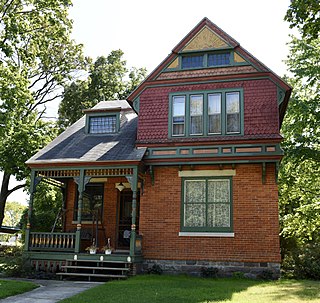
The Buchanan North and West Neighborhoods Historic District is a residential historic district located in Buchanan, Michigan and roughly bounded by Main, 4th, Chippewa, West Front, South Detroit, Chicago, Clark, Roe, and Charles Streets. It was listed on the National Register of Historic Places in 2011.
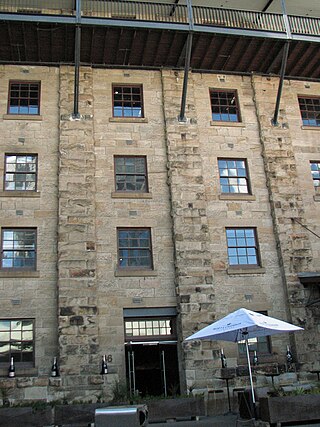
The MSB Stores Complex is a heritage-listed former warehouse and gas manufacturing plant and now offices and storage located at 2-4 Jenkins Street, in the inner city Sydney suburb of Millers Point in the City of Sydney local government area of New South Wales, Australia. It was built from 1844. It is also known as Maritime Services Board Office and Store and Australian Gas Light Company Stores and Offices. It was added to the New South Wales State Heritage Register on 18 April 2000.






















